Soccer drills
- Each player stand at a pylon
- Playing by calling a name first
- The exercise is made more difficult by touching the ball with a maximum of 2 or 3 times.
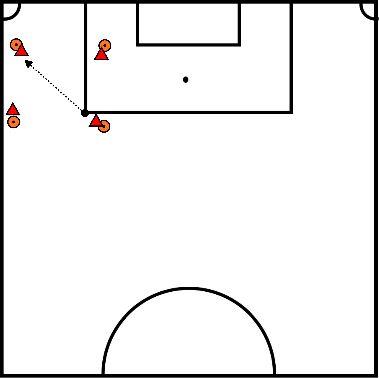
- Positional defending needs to be very good
- Forcing opponent to play wide
- Take away ball
- Keep seeing the ball
- Without fouls preventing the scoring of the opponent
- Keeping an overview, seeing more than just direct opponent (covering your back)
- Working together (creating small spaces) to hold up the other party
- Start dribbling immediately
- Act fast, try to pass directly
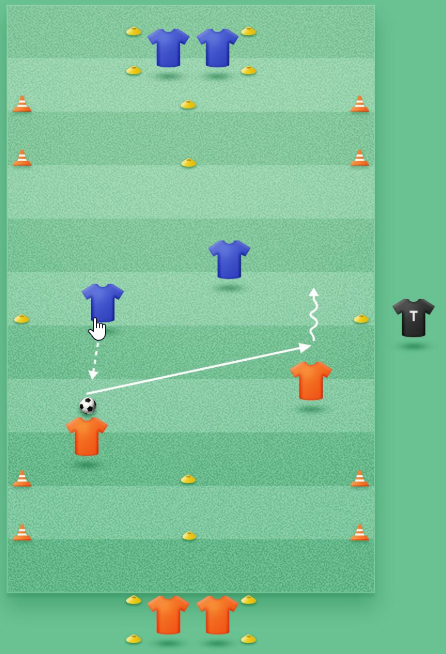
- Player 1 and Player 2 start dribbling at the same time.
- At the end they pass through pawns to the other side.
- The next player receives the ball and starts dribbling.
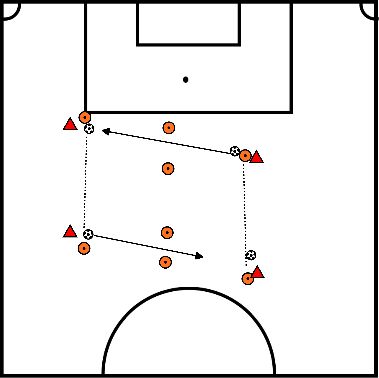
- Scoring by dribbling across the goal line
- Playing out the situation through positional play
- Ball handling in position play
- Act fast, look for a pass directly
- Overview of the situations for moving the game and choosing the moment and direction of the passing action
- Cutting off the opponent's pass and shielding the ball
- Coaching defenders to cut off the line of the pass
- Defenders coach on giving back coverage (standing diagonally behind each other)
2 teams
- The players have to play football 4 against 2 and must have replayed at least 3 times in the attack and a maximum of 10 times before scoring.
- When a ball is taken off/ touched/ crosses the line or a score is scored, there must be a switch between attacking and defending.
- When there is no overplay, no scoring is allowed.
- The idea is to be able to play a game in corona time.
- The idea comes from a table soccer game
- Each player has his own space they are not allowed to leave.
- By passing, the ball can be brought to the other player
- Defense is allowed as long as it remains in his/her own discipline.
- The field can be adjusted to the number of players
Further goals:
- Passing
- Positioning game
- Shooting Distance
- The exercise can be made more difficult by making the game faster
- By only hitting the ball 2 or 3 times and playing quickly
- After all, during a match you don't have that much time either
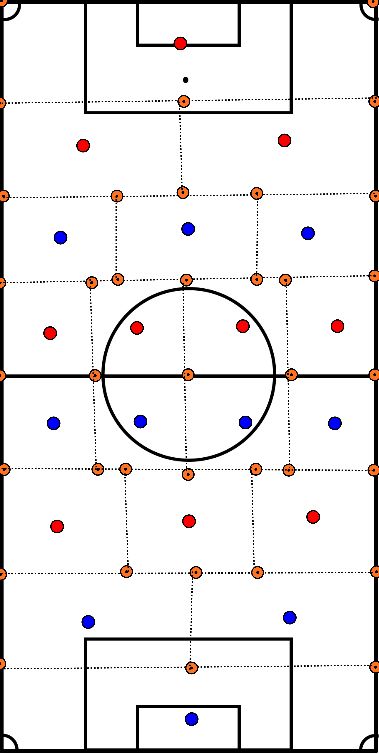
- We have a large rectangle.
- 1 team of 8 players. 1 team of 4 players
- On the short sides of the rectangle is 1 handball, on the long sides 2.
- In total there are 6 handball players and 2 players in the middle.
- The other team of 4 players is in the middle.
- The team of 8 tries to keep possession of the ball and uses the handball players and other players.
tries to replay 10 times.
- Pass and kick with variations in finishing and build-up
- Keeper throws out, striker gets the ball and closes in
- Keeper shoots out, playing striker with back to goal, striker turns away
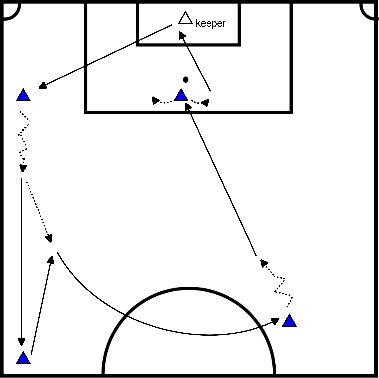
- All players jog in over the field (square)
- Half the number of players has a ball
- players with ball pass the ball to a player without ball (eye contact).
- The players are not allowed to keep the ball with them for longer than 5 sec.
- At the moment the trainer whistles (signal), all players without a ball sprint as fast as possible to the closest player who has a ball and try to take it away.
- The player who has the ball should try to fence it off. (1:1 duel)
- When the trainer blows the whistle again we switch back to jogging and passing!
Nice variant is when you have an odd number of players, the player who can't find a direct opponent gets a command (for example sprint over the width of the field).
- Players face each other briefly in pairs.
- On the ground between the two players lies a ball.
- Trainer gives the commands:
- Head,
- chin,
- knees,
- feet,
- ears,
- BALL!
- On the command BALL! the players must try to get the ball as fast as possible.
- On the other commands they tap the corresponding body part
- The players line up in a circle,
- Ideal is 6 to 8 players per circle.
- Per circle you only have one ball.
EXECUTION:
- A player plays the ball to another player, chasing the ball towards the player he is playing.
- The second player receives the ball and plays it back to another player in the circle,
- He, too, will chase the ball towards the player he has just played in.
- This keeps repeating itself.
QUALITY:
- Passes must be clear and accurate.
- The passes are played over the ground, keep the ball low!
- Just after the pass the players accelerate (short sprint)
- Players call the name of the player they want to play in
- All players constantly stand on their toes, not on flat feet, to improve the speed of action.
PROGRESS:
- You can make the game more difficult by hitting once.
- You can play with two balls
- Player 1, who has given the pass, should try to tap the player who has played the pass (player 2) before playing the ball to player 3, etc.
Exercise1 RUN STRAIGHT FORWARD
- Jog to the last pylon.
- Make sure your upper body is upright.
- Your hips, knees and feet should form a line.
- Don't let your knees buckle inwards.
- On the way back, run a little faster.
- Do the exercise twice.
Exercise 2 RAISE KNEE AND TURN UPPER LEG OUTWARDS WHILE RUNNING
- Jog to the first pylon.
- Stop and raise your knee forward.
- Turn your knee out and put your foot down.
- Keep your pelvis horizontal and your upper body still.
- The hip, knee and foot of the supporting leg together form a straight line.
- Do not let the knee of the supporting leg bend inwards.
- Jog to the next pylon and repeat the exercise with the other leg.
- When you have finished the course, jog back. Do the exercise twice.
Exercise 3 RAISE KNEE AND TURN UPPER LEG INWARDS WHILE RUNNING
- Jog to the first pylon.
- Stop and raise your knee sideways.
- Turn your knee inwards and put your foot down.
- Keep your pelvis horizontal and your upper body still.
- The hip, knee and foot of the supporting leg together form a straight line.
- Do not let the knee of the supporting leg bend inwards.
- Jog to the next pylon and repeat the exercise with the other leg.
- When you have finished the course, jog back.
- Do the exercise twice.
Exercise 4 RUNNING AROUND A PARTNER
- Jog to the first pylon.
- Shuffle sideways, at an angle of 90 degrees to your partner, shuffle a whole circle around each other (without changing your direction of view).
- and back to the first pylon.
- Bend your hips and knees slightly and move your body weight to the ball of your feet.
- Do not let your knees bend inwards.
- Jog to the next pylon and repeat the exercise.
- When you have finished the course, jog back.
- Do the exercise twice.
Exercise 5 JUMP AND TOUCH SHOULDERS WHEN RUNNING
- Jog to the first pylon.
- Shuffle sideways, at an angle of 90 degrees to your partner.
- Jump in the middle towards each other to make shoulder to shoulder contact.
- Land on both feet with your hips and knees bent.
- Do not let your knees bend inwards.
- Shuffle back to the first pylon.
- Jog to the next cap and repeat the exercise.
- When you are ready with the course, jog back.
- Do the exercise twice.
Exercise 6 RUN ACCELERATING AND SLOWING DOWN
- Run quickly to the second pylon
- and then run backwards to the first pylon;
- keep your hips and knees slightly bent.
- Always run two pylons forward and one back.
- When you're done with the course, jog back.
- Do the exercise twice.








